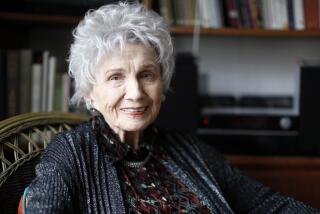Man’s Fate Hinges on Testimony of Daughter, 3
On the morning of last Aug. 22, Darlene Conklin, a 38-year-old Reseda housewife, was opening her refrigerator door when someone stuck a .38-caliber revolver at the base of her neck and fired a single shot.
The person who led police to the murder suspect--Harry Conklin, Darlene’s 39-year-old husband--was the couple’s daughter, Amanda. She told detectives and a police-appointed psychologist she was an eyewitness.
The problem was Amanda’s age: 3.
The question now before Van Nuys Superior Court Judge Melvin B. Grover is whether the testimony of such a witness should be allowed in court.
Would Be One of Youngest
Legal and medical experts say that if the girl, who was 37 months old at the time of the slaying, is found qualified by Grover to serve as a witness, she will be one of the youngest ever allowed in a California court.
After two days of questioning the child by defense and prosecution attorneys, Grover on Thursday said he will make his decision today.
According to California law, no person can be disqualified from testifying in a court of law unless it can be proven that the person is unable to express himself, or that the person does not understand the duty of a witness to tell the truth.
During more than three hours on the witness stand in qualifying hearings Wednesday and Thursday in Grover’s court, Amanda Conklin answered dozens of questions, detailing the day her mother was killed. She occasionally left the chair and crawled on her knees in the witness box.
The unusual case drew not only family members but also dozens of court-watchers and deputy district attorneys.
The questions posed to Amanda this week were aimed solely at establishing her competence, not her father’s guilt. The trial jury will not be selected until the issue of her fitness as a witness is resolved.
On the stand, the girl avoided looking at her father, who sat 15 feet in front of her.
Judge Grover asked her why.
“I don’t want to look at my daddy because of what he did to my mommy,” she said, toying with a plastic cup and spoon.
“What did you see?” Grover asked.
“My mommy on the floor,” she said.
When Grover asked her to elaborate, the girl said, “I was in the kitchen when I heard the gun.”
If the girl is not allowed to testify, prosecutors say they will be hard-pressed to prove Conklin’s guilt.
“She is the only link between the murder and the father,” Deputy Dist. Atty. Robert McIntosh said. “That’s about all we have to go on.”
Deputy Dist. Atty. Gail Tamler, a specialist in the agency’s child abuse section, which handles hundreds of cases of children who are called to testify in court, said she had never heard of a younger witness than Amanda.
UCLA child psychiatrist Spencer Eth, the author of a 1984 study about children who witness homicides, said, “If not the youngest, she’s got be to one of the very youngest.”
Eth said that in a case like the Conklin murder, a child of Amanda’s age can be a reliable witness.
He said preschool children cannot recall details and are unaware of time elements when asked to remember specific events, but they usually do not have the sophistication needed to fabricate.
“They may have selective recall; they may embellish stories with elaboration. But they don’t intentionally lie,” Eth said. Unlike adults, who can block out a catastrophic event through a process known as traumatic amnesia, Eth said children usually can clearly recall central actions of an important event.
“The issue is whether Amanda can perceive, recollect and communicate her recollections about the relevant matters in the case,” said prosecutor McIntosh.
“What she saw that day is a snapshot in her mind. All we want is to be allowed to see the content of that snapshot.”
When detectives were called to the site of the slaying, which occurred on the 17600 block of LeMay Place, they found no murder weapon, nor could they ascertain a motive. The house and all its belongings were intact, and there were no signs of a struggle, they said.
Why would anyone want to kill Darlene Conklin, who from all accounts was a loving and devoted wife and mother?
A week after the murder, Amanda told authorities her father had killed her mother. A month after that, Harry Conklin, a part-time 20th Century Fox Studios grip, was arrested. Unable to post $200,000 bail, he remains in custody at Los Angeles County Jail.
Amanda was found by her aunt, Brenda Barry, at about 1 p.m. on the day of the slaying. She was sitting in her bedroom with the door wedged shut from the outside.
Barry, the sister of the dead woman, testified at a preliminary hearing in November that the girl had “a look on her face I had never seen. She was scared, frightened . . . her color was terrible. I had never seen that color skin on her.”
When police Detective Patrick Conmay talked to Amanda the next day, she told him, “Daddy knocked my mommy down and put me in my room.”
Friend’s Testimony
Two pieces of circumstantial evidence were introduced at the preliminary hearing.
A friend of the Conklins, Robert Regalado, testified that the couple’s four-year marriage had deteriorated. When asked about the relationship, Regalado said Harry Conklin had told him “how unhappy he was. Darlene had been nagging him and breathing down his back. And he said, ‘You know, I am going to have to get rid of her.’ ”
Regalado said he then asked Conklin, “Well, why don’t you just divorce her or walk away?”
“No,” Regalado recalled Conklin’s saying. “I will figure something out.”
Book on Murder
But perhaps the most curious evidence introduced at the preliminary hearing was a book entitled “Death Dealer’s Manual,” written by Bradley J. Steiner. According to a stamp inside the book, it was purchased at a North Hollywood survivalist store.
The book, found inside the headboard in the couple’s bedroom, is a step-by-step guide to murder.
Detectives at the hearing said the methods listed in the book nearly match those used to kill Darlene Conklin.
“The book indicated that the primary place to shoot a person would be at the base of the brain, and the other place would be the spinal cord,” Detective Joseph Diglio testified. “The book also indicated to destroy and get rid of the weapon, because without the weapon, the police couldn’t put a case together.”
Psychologist’s Interview
One week after the slaying, police took Amanda to child psychologist Joy Graves, who interviewed the girl over 14 sessions.
Reading her notes aloud Thursday in court, Graves testified that at the first session, Amanda was asked to act out the the day of the slaying by using dolls.
“She threw the father doll away and looked anxious, her eyes becoming wide. She froze and her eyes were wide open. She stated her daddy hit her mommy in the kitchen.”
But Conklin’s attorney, Deputy Public Defender Barry Taylor, argued Thursday that such testimony from the girl could be a fabrication.
Capacity Questioned
“She doesn’t have a sufficient capacity to recollect what happened on the day of the slaying, as opposed to what she’s been told happened,” Taylor said in an interview.
He pointed to the fact that since Aug. 22, Amanda has been staying with her aunt, Barry, who he says may have influenced the girl and colored her recollection.
“She has been programmed by several people,” Taylor said. “The question is at what point does she tell us what she actually remembers as opposed to what other people have told her what they think happened?”
More to Read
Sign up for Essential California
The most important California stories and recommendations in your inbox every morning.
You may occasionally receive promotional content from the Los Angeles Times.










